Combined Geophysical Methods in Extreme Environments—An Example from the Dead Sea
Abstract
:1. Introduction
2. Geological Background
3. Materials and Methods
4. Results
5. Discussion
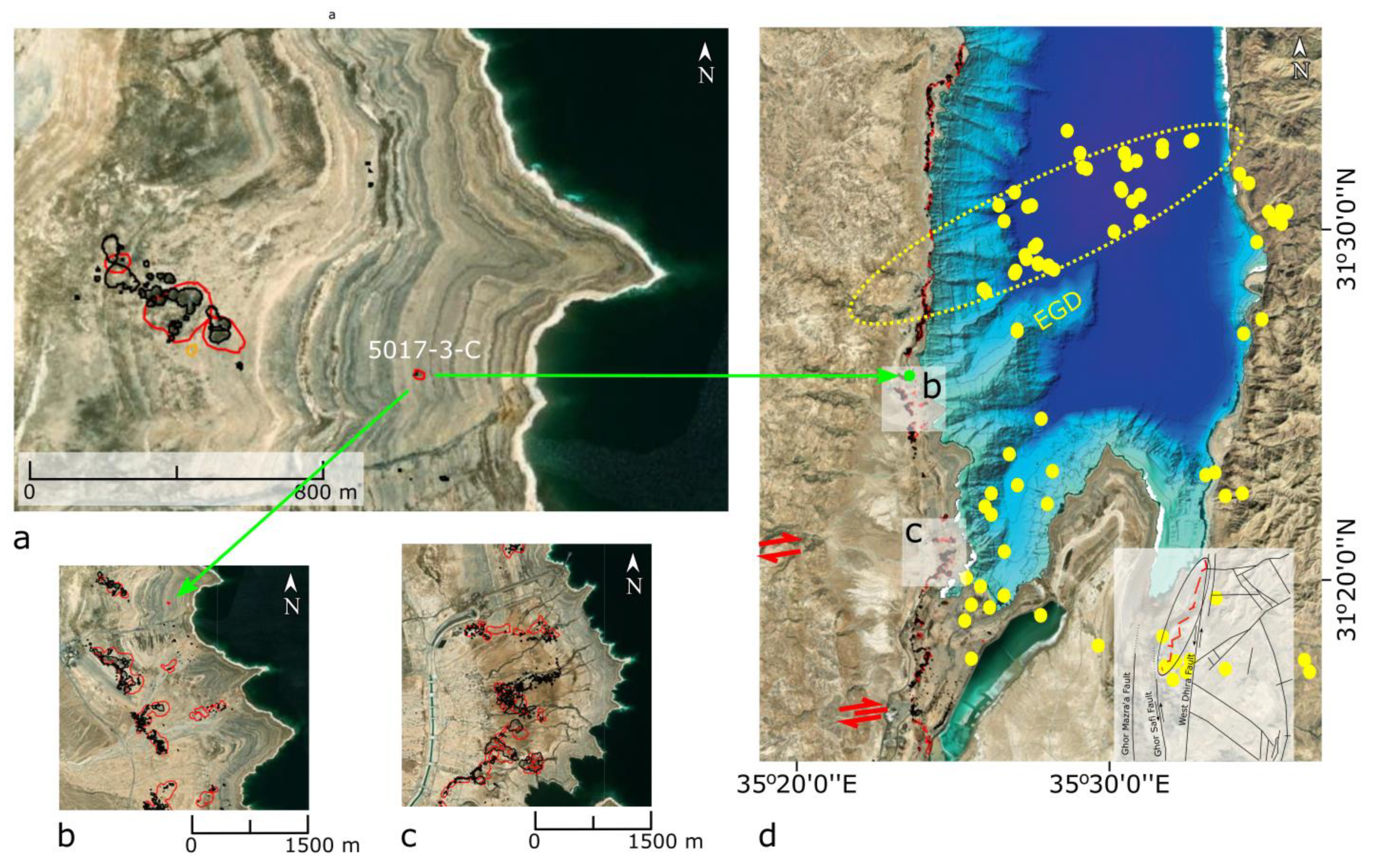
6. Conclusions
Supplementary Materials
Author Contributions
Funding
Data Availability Statement
Acknowledgments
Conflicts of Interest
References
- Choudhury, K.; Saha, D.K. Integrated Geophysical and Chemical Study of Saline Water Intrusion. Groundwater 2004, 42, 671–677. [Google Scholar] [CrossRef] [PubMed]
- Obikoya, I.B.; Bennell, J.D. Geophysical Investigation of the Fresh-Saline Water Interface in the Coastal Area of Abergwyngregyn. J. Environ. Prot. 2012, 3, 1039–1046. [Google Scholar] [CrossRef]
- Costall, A.; Harris, B.; Pigois, J.P. Electrical Resistivity Imaging and the Saline Water Interface in High-Quality Coastal Aquifers. Surv. Geophys. 2018, 39, 753–816. [Google Scholar] [CrossRef]
- Bristow, C.S.; Jol, H.M. Ground Penetrating Radar in Sediments; Geological Society of London: London, UK, 2003; ISBN 978-1-86239-459-9. [Google Scholar]
- Conyers, L.B. Ground-Penetrating Radar for Archaeology; Geophysical Methods for Archaeology; AltaMira Press: Walnut Creek, CA, USA, 2004; ISBN 978-0-7591-0773-1. [Google Scholar]
- Rogers, M.; Leon, J.F.; Fisher, K.D.; Manning, S.W.; Sewell, D. Comparing Similar Ground-Penetrating Radar Surveys Under Different Moisture Conditions at Kalavasos-Ayios Dhimitrios, Cyprus. Archaeol. Prospect. 2012, 19, 297–305. [Google Scholar] [CrossRef]
- Ezersky, M.; Eppelbaum, L.V.; Legchenko, A. Geophysical Methods Applied to the Sinkhole Investigation at the Dead Sea Coasts. In Applied Geophysics for Karst and Sinkhole Investigation: The Dead Sea and Other Regions; IOP Publishing: Bristol, UK, 2023. [Google Scholar]
- Ezersky, M.G.; Eppelbaum, L.V.; Al-Zoubi, A.; Keydar, S.; Abueladas, A.; Akkawi, E.; Medvedev, B. Geophysical Prediction and Following Development Sinkholes in Two Dead Sea Areas, Israel and Jordan. Environ. Earth Sci. 2013, 70, 1463–1478. [Google Scholar] [CrossRef]
- Closson, D.; Abou Karaki, N. Sinkhole Hazards Prediction at Ghor Al Haditha, Dead Sea, Jordan: “Salt Edge” and “Tectonic” Models Contribution—A Rebuttal to “Geophysical Prediction and Following Development Sinkholes in Two Dead Sea Areas, Israel and Jordan, by: Ezersky, M.G., Eppelbaum, L.V., Al-Zoubi, A.3, Keydar, S., Abueladas, A.-R., Akkawi, E., and Medvedev, B.”. Environ. Earth Sci. 2013, 70, 2919–2922. [Google Scholar] [CrossRef]
- Legchenko, A.; Ezersky, M.; Camerlynck, C.; Al-Zoubi, A.; Chalikakis, K. Joint Use of TEM and MRS Methods in a Complex Geological Setting. Comptes Rendus Geosci. 2009, 341, 908–917. [Google Scholar] [CrossRef]
- Ten Brink, U.S.; Ben-Avraham, Z. The Anatomy of a Pull-Apart Basin: Seismic Reflection Observations of the Dead Sea Basin. Tectonics 1989, 8, 333–350. [Google Scholar] [CrossRef]
- Ten Brink, U.S.; Flores, C.H. Geometry and Subsidence History of the Dead Sea Basin: A Case for Fluid-Induced Mid-Crustal Shear Zone? J. Geophys. Res. Solid Earth 2012, 117, B01406. [Google Scholar] [CrossRef]
- Neev, D.; Hall, J.K. Geophysical Investigations in the Dead Sea. Sediment. Geol. 1979, 23, 209–238. [Google Scholar] [CrossRef]
- Pe’eri, S.; Zebker, H.A.; Ben-Avraham, Z.; Frumkin, A.; Hall, J.K. Spatially-Resolved Uplift Rate of the Mount Sedom (Dead Sea) Salt Diapir from InSAR Observations. Isr. J. Earth Sci. 2004, 53, 99–106. [Google Scholar] [CrossRef]
- Coianiz, L.; Schattner, U.; Lang, G.; Ben-Avraham, Z.; Lazar, M. Between Plate and Salt Tectonics—New Stratigraphic Constraints on the Architecture and Timing of the Dead Sea Basin during the Late Quaternary. Basin Res. 2020, 32, 636–651. [Google Scholar] [CrossRef]
- Neev, D.; Emery, K.O. The Dead Sea: Depositional Processes and Environments of Evaporites; Geological Survey: Jeruslaem, Israel, 1967. [Google Scholar]
- Begin, Z.B.; Begîn, Z.B.; Ehrlich, A.; Nathan, Y. Lake Lisan: The Pleistocene Precursor of the Dead Sea; Ministry of Commerce and Industry, Geological Survey: Jeruslaem, Israel, 1974.
- Stein, M.; Starinsky, A.; Katz, A.; Goldstein, S.L.; Machlus, M.; Schramm, A. Strontium Isotopic, Chemical, and Sedimentological Evidence for the Evolution of Lake Lisan and the Dead Sea. Geochim. Cosmochim. Acta 1997, 61, 3975–3992. [Google Scholar] [CrossRef]
- Stein, M. The Evolution of Neogene-Quaternary Water-Bodies in the Dead Sea Rift Valley. In Dead Sea Transform Fault System: Reviews; Garfunkel, Z., Ben-Avraham, Z., Kagan, E., Eds.; Springer: Dordrecht, The Netherlands, 2014; pp. 279–316. ISBN 978-94-017-8872-4. [Google Scholar]
- Bartov, Y.; Goldstein, S.L.; Stein, M.; Enzel, Y. Catastrophic Arid Episodes in the Eastern Mediterranean Linked with the North Atlantic Heinrich Events. Geology 2003, 31, 439–442. [Google Scholar] [CrossRef]
- Bookman, R.; Enzel, Y.; Agnon, A.; Stein, M. Late Holocene Lake Levels of the Dead Sea. GSA Bull. 2004, 116, 555–571. [Google Scholar] [CrossRef]
- Haase-Schramm, A.; Goldstein, S.L.; Stein, M. U-Th Dating of Lake Lisan (Late Pleistocene Dead Sea) Aragonite and Implications for Glacial East Mediterranean Climate Change. Geochim. Cosmochim. Acta 2004, 68, 985–1005. [Google Scholar] [CrossRef]
- Prasad, S.; Vos, H.; Negendank, J.F.W.; Waldmann, N.; Goldstein, S.L.; Stein, M. Evidence from Lake Lisan of Solar Influence on Decadal- to Centennial-Scale Climate Variability during Marine Oxygen Isotope Stage 2. Geology 2004, 32, 581–584. [Google Scholar] [CrossRef]
- Stein, M.; Torfstein, A.; Gavrieli, I.; Yechieli, Y. Abrupt Aridities and Salt Deposition in the Post-Glacial Dead Sea and Their North Atlantic Connection. Quat. Sci. Rev. 2010, 29, 567–575. [Google Scholar] [CrossRef]
- Torfstein, A.; Goldstein, S.L.; Stein, M.; Enzel, Y. Impacts of Abrupt Climate Changes in the Levant from Last Glacial Dead Sea Levels. Quat. Sci. Rev. 2013, 69, 1–7. [Google Scholar] [CrossRef]
- Neugebauer, I.; Brauer, A.; Schwab, M.J.; Waldmann, N.D.; Enzel, Y.; Kitagawa, H.; Torfstein, A.; Frank, U.; Dulski, P.; Agnon, A.; et al. Lithology of the Long Sediment Record Recovered by the ICDP Dead Sea Deep Drilling Project (DSDDP). Quat. Sci. Rev. 2014, 102, 149–165. [Google Scholar] [CrossRef]
- Kiro, Y.; Goldstein, S.L.; Garcia-Veigas, J.; Levy, E.; Kushnir, Y.; Stein, M.; Lazar, B. Relationships between Lake-Level Changes and Water and Salt Budgets in the Dead Sea during Extreme Aridities in the Eastern Mediterranean. Earth Planet. Sci. Lett. 2017, 464, 211–226. [Google Scholar] [CrossRef]
- Lu, Y.; Waldmann, N.; Nadel, D.; Marco, S. Increased Sedimentation Following the Neolithic Revolution in the Southern Levant. Glob. Planet. Chang. 2017, 152, 199–208. [Google Scholar] [CrossRef]
- Coianiz, L.; Ben-Avraham, Z.; Stein, M.; Lazar, M. Spatial and Temporal Reconstruction of the Late Quaternary Dead Sea Sedimentary Facies from Geophysical Properties. J. Appl. Geophys. 2019, 160, 15–27. [Google Scholar] [CrossRef]
- Coianiz, L.; Bialik, O.M.; Ben-Avraham, Z.; Lazar, M. Late Quaternary Lacustrine Deposits of the Dead Sea Basin: High Resolution Sequence Stratigraphy from Downhole Logging Data. Quat. Sci. Rev. 2019, 210, 175–189. [Google Scholar] [CrossRef]
- Torfstein, A.; Enzel, Y. Dead Sea Lake Level Changes and Levant Palaeoclimate. In Quaternary of the Levant; Enzel, Y., Bar-Yosef, O., Eds.; Cambridge University Press: Cambridge, UK, 2017; pp. 115–126. ISBN 978-1-316-10675-4. [Google Scholar]
- Bookman, R. The Dead Sea and Its Deviation from Natural Conditions. In Large Asian Lakes in a Changing World: Natural State and Human Impact; Mischke, S., Ed.; Springer International Publishing: Cham, Switzerland, 2020; pp. 1–33. ISBN 978-3-030-42254-7. [Google Scholar]
- Migowski, C.; Stein, M.; Prasad, S.; Negendank, J.F.W.; Agnon, A. Holocene Climate Variability and Cultural Evolution in the Near East from the Dead Sea Sedimentary Record. Quat. Res. 2006, 66, 421–431. [Google Scholar] [CrossRef]
- Yechieli, Y.; Magaritz, M.; Levy, Y.; Weber, U.; Kafri, U.; Woelfli, W.; Bonani, G. Late Quaternary Geological History of the Dead Sea Area, Israel. Quat. Res. 1993, 39, 59–67. [Google Scholar] [CrossRef]
- Haliva-Cohen, A.; Stein, M.; Goldstein, S.L.; Sandler, A.; Starinsky, A. Sources and Transport Routes of Fine Detritus Material to the Late Quaternary Dead Sea Basin. Quat. Sci. Rev. 2012, 50, 55–70. [Google Scholar] [CrossRef]
- Abelson, M.; Baer, G.; Shtivelman, V.; Wachs, D.; Raz, E.; Crouvi, O.; Kurzon, I.; Yechieli, Y. Collapse-sinkholes and Radar Interferometry Reveal Neotectonics Concealed within the Dead Sea Basin. Geophys. Res. Lett. 2003, 30, 2003GL017103. [Google Scholar] [CrossRef]
- Lazar, M.; Engoltz, K.; Basson, U.; Yasur-Landau, A. Water Saturated Sand and a Shallow Bay: Combining Coastal Geophysics and Underwater Archaeology in the South Bay of Tel Dor. Quat. Int. 2018, 473, 112–119. [Google Scholar] [CrossRef]
- Lazar, M.; Basson, U.; Himmelstein, A.G.; Levy, T.E.; Arkin Shalev, E.; Yasur-Landau, A. The Door to Dor: Tracing Unseen Anthropogenic Impact in an Ancient Port. Geoarchaeology 2021, 36, 203–212. [Google Scholar] [CrossRef]
- Won, I.J.; Keiswetter, D.A.; Fields, G.R.A.; Sutton, L.C. GEM-2: A New Multifrequency Electromagnetic Sensor. J. Environ. Eng. Geophys. 1996, 1, 129–137. [Google Scholar] [CrossRef]
- Huang, H.; Won, I.J. Real-time Resistivity Sounding Using a Hand-held Broadband Electromagnetic Sensor. Geophysics 2003, 68, 1224–1231. [Google Scholar] [CrossRef]
- Huang, H. Depth of Investigation for Small Broadband Electromagnetic Sensors. Geophysics 2005, 70, G135–G142. [Google Scholar] [CrossRef]
- Sudduth, K.A.; Kitchen, N.R.; Wiebold, W.J.; Batchelor, W.D.; Bollero, G.A.; Bullock, D.G.; Clay, D.E.; Palm, H.L.; Pierce, F.J.; Schuler, R.T.; et al. Relating Apparent Electrical Conductivity to Soil Properties across the North-Central USA. Comput. Electron. Agric. 2005, 46, 263–283. [Google Scholar] [CrossRef]
- Spies, B.R. Depth of Investigation in Electromagnetic Sounding Methods. Geophysics 1989, 54, 872–888. [Google Scholar] [CrossRef]
- Goldshleger, N.; Basson, U.; Azaria, I.; Fastig, S. Using Combined Close-Range Active and Passive- Remote Sensing Methods to Detect Sinkholes. J. Remote Sens. GIS 2018, 7, 222. [Google Scholar] [CrossRef]
- Goldshleger, N.; Basson, U. Utilization of Ground-Penetrating Radar and Frequency Domain Electromagnetic for Investigation of Sewage Leaks. In Environmental Applications of Remote Sensing; Marghany, M., Ed.; InTech: London, UK, 2016; ISBN 978-953-51-2443-6. [Google Scholar]
- Goldshleger, N.; Shamir, O.; Basson, U.; Zaady, E. Frequency Domain Electromagnetic Method (FDEM) as a Tool to Study Contamination at the Sub-Soil Layer. Geosciences 2019, 9, 382. [Google Scholar] [CrossRef]
- McNeill, J.D. Electrical Conductivity of Soils and Rocks; Technical Note 5; Geonics LTD: Mississauga, ON, Canada, 1980. [Google Scholar]
- Beamish, D. Low Induction Number, Ground Conductivity Meters: A Correction Procedure in the Absence of Magnetic Effects. J. Appl. Geophys. 2011, 75, 244–253. [Google Scholar] [CrossRef]
- Weymer, B.A.; Everett, M.E.; Houser, C.; Wernette, P.; Barrineau, P. Differentiating Tidal and Groundwater Dynamics from Barrier Island Framework Geology: Testing the Utility of Portable Multifrequency Electromagnetic Induction Profilers. Geophysics 2016, 81, E347–E361. [Google Scholar] [CrossRef]
- Huang, H.; Deszcz-Pan, M.; Smith, B. Limitations of Small EM Sensors in Resistive Terrain. In Symposium on the Application of Geophysics to Engineering and Environmental Problems Proceedings; The Environmental and Engineering Geophysical Society: Denver, CO, USA, 2008; pp. 163–180. [Google Scholar]
- Jadoon, K.Z.; Altaf, M.U.; McCabe, M.F.; Hoteit, I.; Muhammad, N.; Moghadas, D.; Weihermüller, L. Inferring Soil Salinity in a Drip Irrigation System from Multi-Configuration EMI Measurements Using Adaptive Markov Chain Monte Carlo. Hydrol. Earth Syst. Sci. 2017, 21, 5375–5383. [Google Scholar] [CrossRef]
- Delefortrie, S.; Saey, T.; Van De Vijver, E.; De Smedt, P.; Missiaen, T.; Demerre, I.; Van Meirvenne, M. Frequency Domain Electromagnetic Induction Survey in the Intertidal Zone: Limitations of Low-Induction-Number and Depth of Exploration. J. Appl. Geophys. 2014, 100, 14–22. [Google Scholar] [CrossRef]
- Shevnin, V.; Mousatov, A.; Ryjov, A.; Delgado-Rodriquez, O. Estimation of Clay Content in Soil Based on Resistivity Modelling and Laboratory Measurements. Geophys. Prospect. 2007, 55, 265–275. [Google Scholar] [CrossRef]
- Crow, H.L.; Hunter, J.A.; Olson, L.C.; Pugin, A.J.-M.; Russell, H.A.J. Borehole Geophysical Log Signatures and Stratigraphic Assessment in a Glacial Basin, Southern Ontario. Can. J. Earth Sci. 2018, 55, 829–845. [Google Scholar] [CrossRef]
- Kayal, J.R. Electrical and Gamma-Ray Logging in Gondwana and Tertiary Coal Fields of India. Geoexploration 1979, 17, 243–258. [Google Scholar] [CrossRef]
- Goldberg, D. The Role of Downhole Measurements in Marine Geology and Geophysics. Rev. Geophys. 1997, 35, 315–342. [Google Scholar] [CrossRef]
- Soua, M. Paleozoic Oil/Gas Shale Reservoirs in Southern Tunisia: An Overview. J. Afr. Earth Sci. 2014, 100, 450–492. [Google Scholar] [CrossRef]
- Shaaban, F.F.; Al-Rashed, A.R. Recognition of Lithostratigraphic Breaks in Undifferentiated Rock Units Using Well Logs: A Flow Chart. J. Geol. Geophys. 2015, 4, 225. [Google Scholar] [CrossRef]
- Lazar, M.; Siebert, C. Out of Sight, out of Mind. Submarine Springs in the Dead Sea—An Underappreciated Phenomenon. Geomorphology 2023, 436, 108777. [Google Scholar] [CrossRef]
- Shamir, G. The Active Structure of the Dead Sea Depression. In New Frontiers in Dead Sea Paleoenvironmental Research; Enzel, Y., Agnon, A., Stein, M., Eds.; Geological Society of America: Boulder, CO, USA, 2006; Volume 401, ISBN 978-0-8137-2401-0. [Google Scholar]
- Wetzler, N.; Sagy, A.; Marco, S. The Association of Micro-Earthquake Clusters with Mapped Faults in the Dead Sea Basin. J. Geophys. Res. Solid Earth 2014, 119, 8312–8330. [Google Scholar] [CrossRef]
- Lazar, M.; Ben-Avraham, Z.; Schattner, U. Formation of Sequential Basins along a Strike–Slip Fault–Geophysical Observations from the Dead Sea Basin. Tectonophysics 2006, 421, 53–69. [Google Scholar] [CrossRef]
- Sagy, A.; Reches, Z.; Agnon, A. Hierarchic Three-Dimensional Structure and Slip Partitioning in the Western Dead Sea Pull-Apart. Tectonics 2003, 22, 1004. [Google Scholar] [CrossRef]
- Bartov, Y.; Sagy, A. Late Pleistocene Extension and Strike-Slip in the Dead Sea Basin. Geol. Mag. 2004, 141, 565–572. [Google Scholar] [CrossRef]
- Closson, D.; Karaki, N.A. Salt Karst and Tectonics: Sinkholes Development along Tension Cracks between Parallel Strike-Slip Faults, Dead Sea, Jordan. Earth Surf. Process. Landf. 2009, 34, 1408–1421. [Google Scholar] [CrossRef]
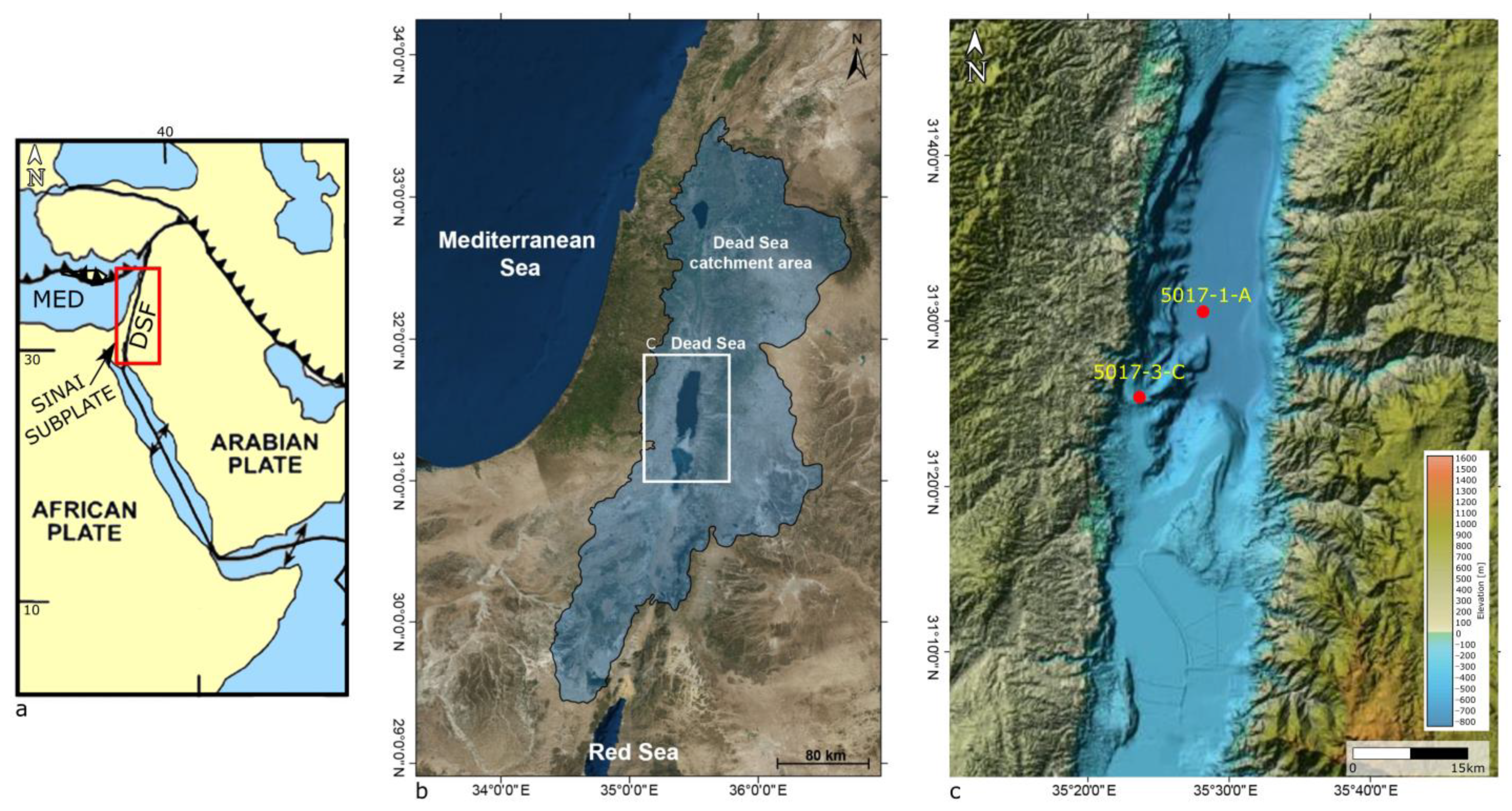
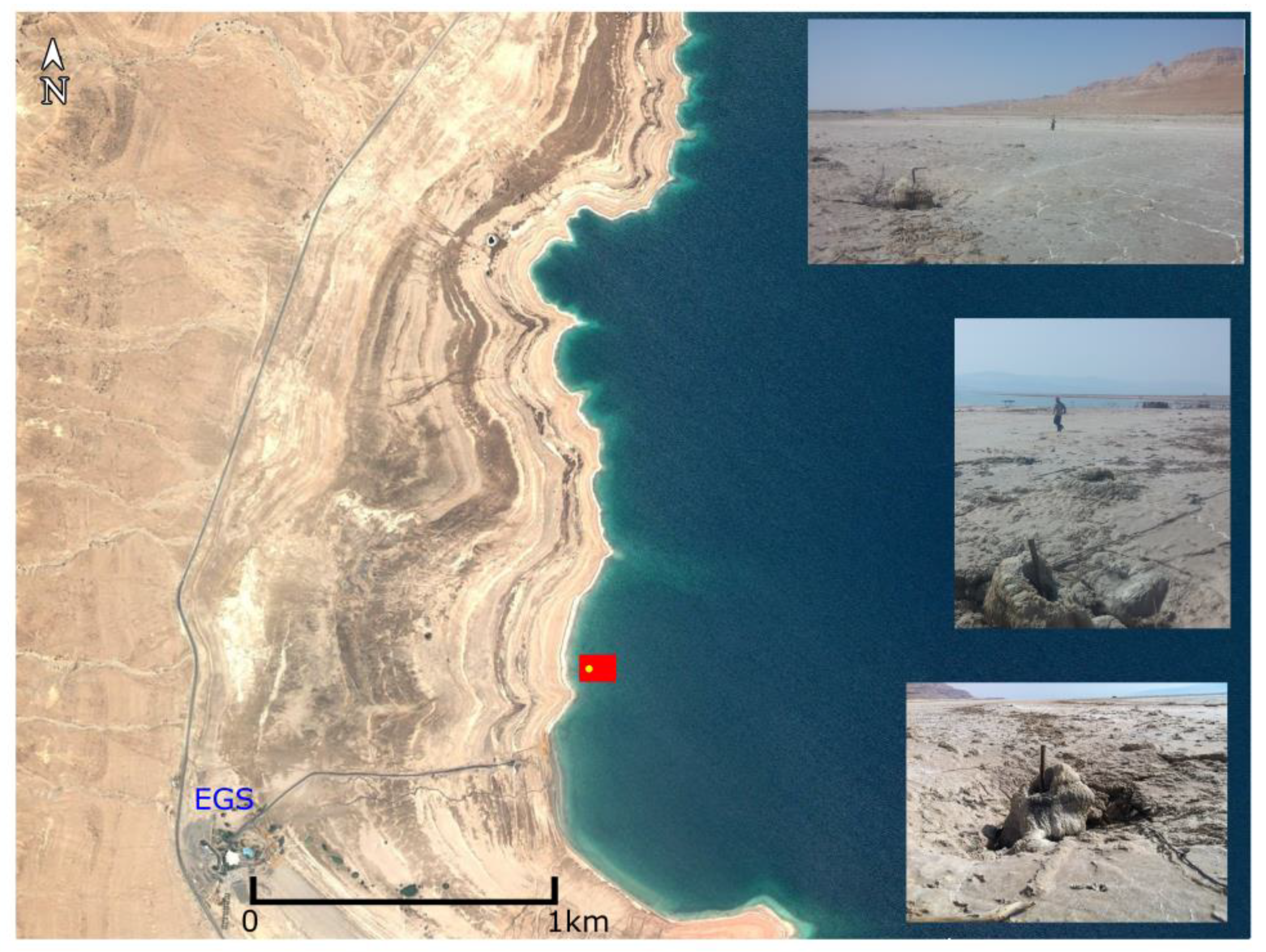
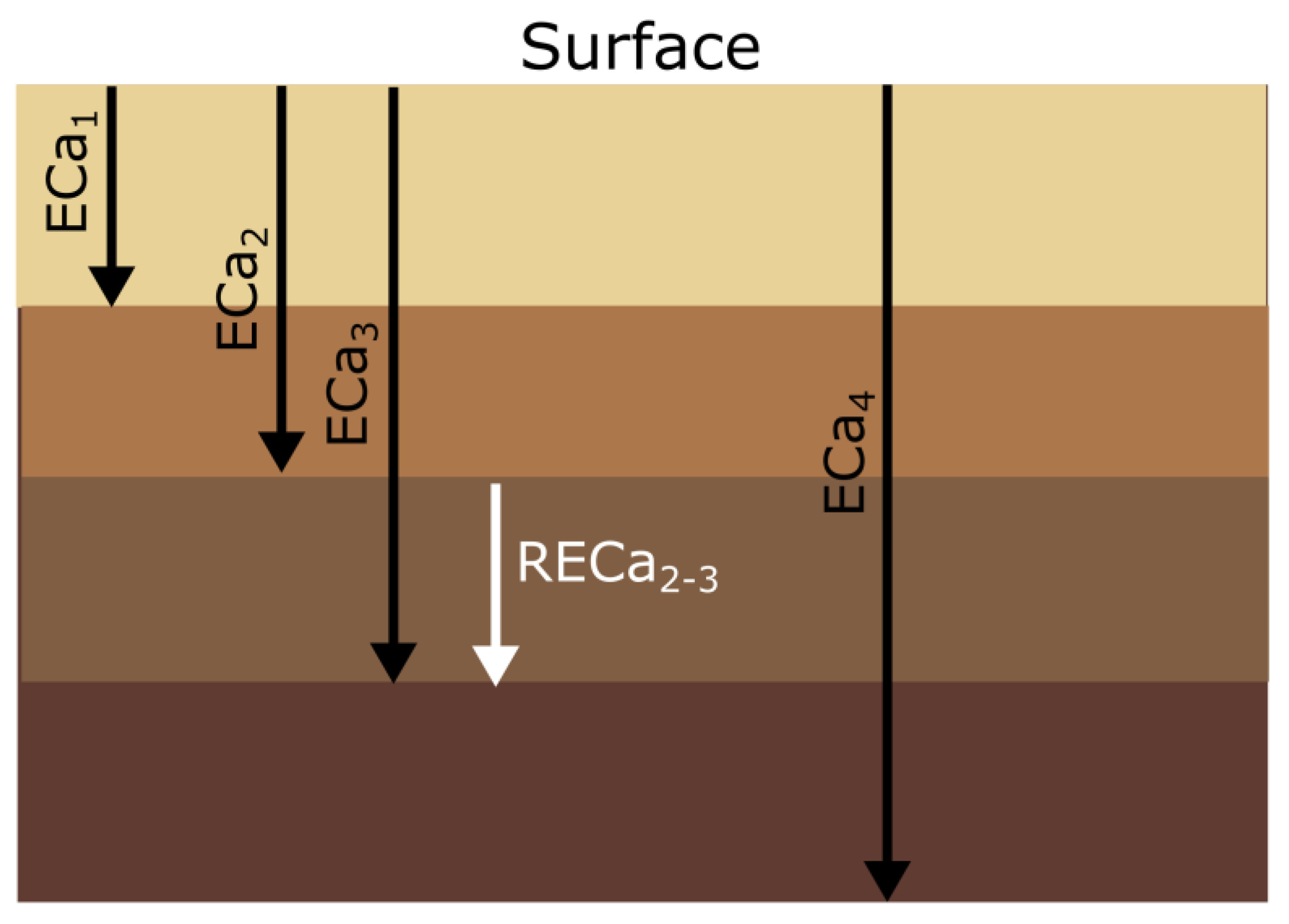
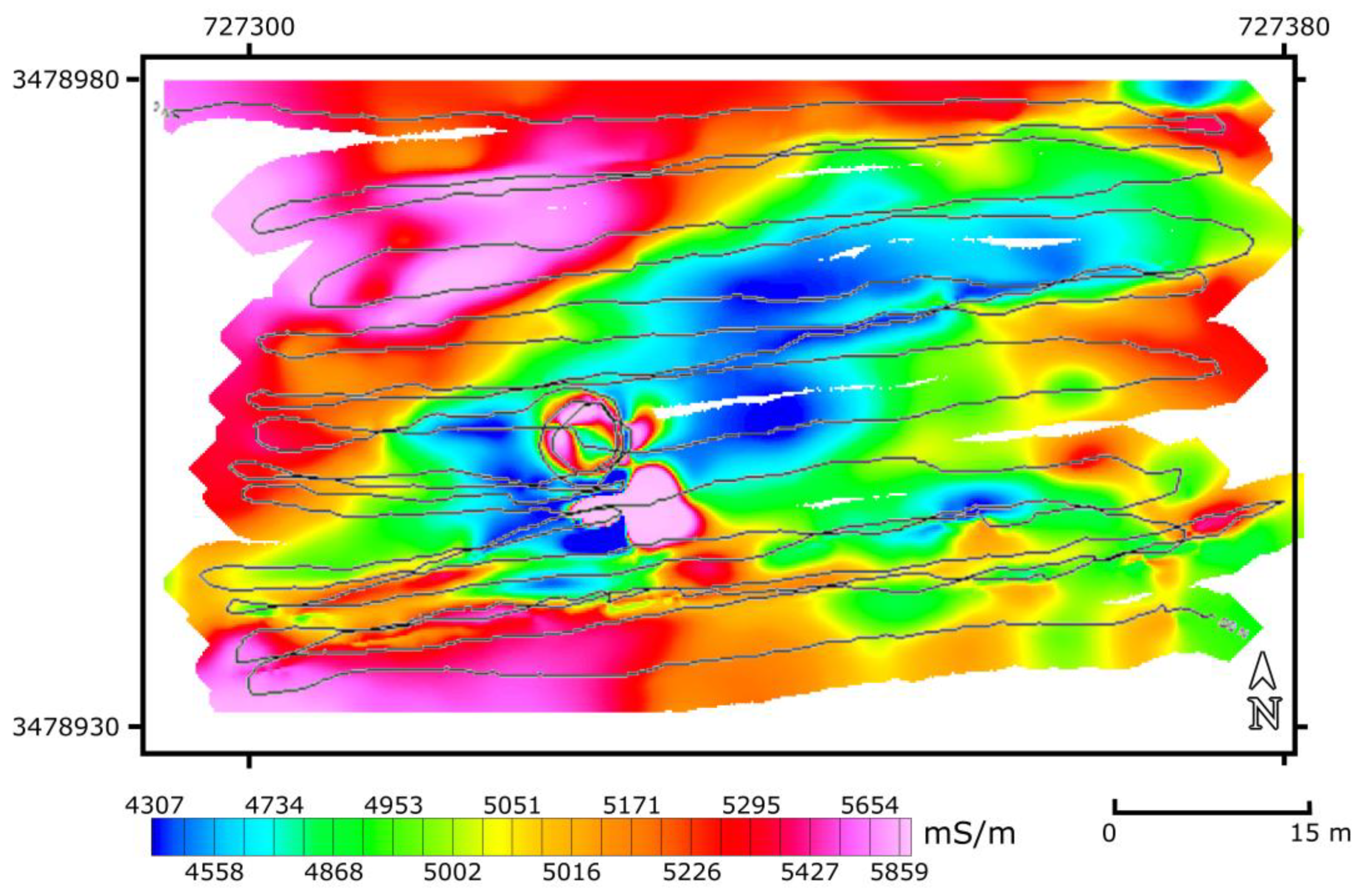

| Frequency (Hz) | Range of Effective Penetration (m) |
|---|---|
| 825 | 5.1–9.1 |
| 1925 | 4.6–7.7 |
| 4425 | 4.0–6.3 |
| 10,425 | 3.1–4.7 |
| 24,425 | 2.1–3.6 |
| 57,225 | 1.7–2.6 |
| Frequency (Hz) | Range of ECa (mS/m) |
|---|---|
| 825–1925 | −340–360 |
| 1925–4425 | −1360–450 |
| 4425–10,425 | −83–3500 |
| 10,425–24,425 | 1820–2520 |
| 24,425–57,225 | −630–−70 |
| 57,225 | 2295–2410 |
Disclaimer/Publisher’s Note: The statements, opinions and data contained in all publications are solely those of the individual author(s) and contributor(s) and not of MDPI and/or the editor(s). MDPI and/or the editor(s) disclaim responsibility for any injury to people or property resulting from any ideas, methods, instructions or products referred to in the content. |
© 2024 by the authors. Licensee MDPI, Basel, Switzerland. This article is an open access article distributed under the terms and conditions of the Creative Commons Attribution (CC BY) license (https://creativecommons.org/licenses/by/4.0/).
Share and Cite
Lazar, M.; Cheng, L.; Basson, U. Combined Geophysical Methods in Extreme Environments—An Example from the Dead Sea. Remote Sens. 2024, 16, 1978. https://doi.org/10.3390/rs16111978
Lazar M, Cheng L, Basson U. Combined Geophysical Methods in Extreme Environments—An Example from the Dead Sea. Remote Sensing. 2024; 16(11):1978. https://doi.org/10.3390/rs16111978
Chicago/Turabian StyleLazar, Michael, Linjing Cheng, and Uri Basson. 2024. "Combined Geophysical Methods in Extreme Environments—An Example from the Dead Sea" Remote Sensing 16, no. 11: 1978. https://doi.org/10.3390/rs16111978






